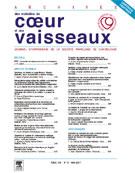01-6 - THE ROLE OF TRANSESOPHAGEAL ECHOCARDIOGRAPHY IN THE MONITORING OF ATRIAL FIBRILLATION ABLATION - 09/04/08
Echahidi Najmeddine,
Jean Champagne, MD,
François Philippon, MD,
André St-Pierre, MD,
Franck Molin, MD,
Louis Blier, MD,
Marcel Gilbert, MD,
Jacques Villeneuve, MD,
Dania Mohty, MD,
Gilles O’ Hara, MD
Voir les affiliationsBackground: Although the success of atrial fibrillation (AF) ablation is encouraging, and complications in experienced laboratories are decreasing, some major complications are still reported. Thus, novel-imaging strategies for AF ablation should enhance the safety of this technique. The role of transesophageal echocardiography (TEE) in this setting has not been prospectively evaluated. This study examined the usefulness of a TEE guided strategy for PVs isolation.
Methods: Under general anaesthesia, 100 patients underwent a TEE-guided strategy for AF ablation. A hybrid technique (combining anatomical and electrophysiological approaches) was performed with circumferential pulmonary veins (PVs) ablation and antrum and ostial electrical isolation guided by TEE. TEE was performed during all the procedure. It excluded left atrial (LA) thrombus, guided transseptal (TS) puncture and catheter positioning, and helped to identify PVs ostia and their velocities. The TEE probe localized the esophagus and monitored its temperature (T°). It also allowed detection of micro bubbles formation (avoiding tissue overheating) and early detection of complications.
Results: Overall, one patient had a LA clot, then the procedure was reported. No transseptal puncture complication occurred. The esophagus was located close to the left PVs in 38 %, the right PV in 28 %, midline in 17 % and with an oblique course in 17 %. The esophagus localization and its T° monitoring was important to avoid (the rare but fatal) esophago-atrial fistula. The right and left superior PVs and their velocities were detected in 100 %, left inferior PV in 88 % and right inferior PV in 82 %. The monitoring of PVs velocities was useful to avoid PVs stenosis. Micro bubbles were detected in 12 patients. Elevation of TEE probe T° occurred in 14 patients and was always noticed when lesions were applied over the TEE probe shadow in close proximity to the posterior wall. Two complications (1 tamponade, 1 PV laceration) occurred and were detected early by TEE with prompt management.
Conclusions: TEE provides advantages over map guided only approaches. It is an excellent tool for a safe trans-septal access, for antrum and PVs Identification, for catheters placement and navigation. TEE is succesful for the prevention of the esophago-atrial fistula by the localization of the esophagus and assessment of its T°, for prevention of the PVs stenosis by delineating PVs ostia and monitoring their velocities, and for early detection of complications.
© 2007 Elsevier Masson SAS. Tous droits réservés.
Vol 100 - N° 12
P. 1071 - décembre 2007 Retour au numéroBienvenue sur EM-consulte, la référence des professionnels de santé.

